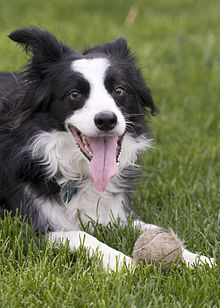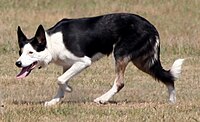Border Collie
The Border Collie is a herding dog breed developed in the Anglo-Scottish border region for herding livestock, especially sheep.
Ranked number one in Stanley Coren's The Intelligence of Dogs and typically extremely energetic, acrobatic, smart and athletic, they frequently compete with great success in dog sports, in addition to their success in sheepdog trials, and are often cited as the most intelligent of all dogs.[1] In January 2011, a Border Collie was reported to have learned 1,022 words, and acts consequently to human citation of those words.
History
The Border Collie is descended from landrace collies, a type found widely in the British Isles. The name for the breed came from its probable place of origin along the Anglo-Scottish border.[4] Mention of the "Collie" or "Colley" type first appeared toward the end of the 19th century, although the word "collie" is older than this and has its origin in Lowland Scots dialects. It is also thought that the word 'collie' comes from the old Celtic word for useful. Many of the best Border Collies today can be traced back to a dog known as Old Hemp.[5]
In 1915, James Reid, Secretary of the International Sheep Dog Society (ISDS) in the United Kingdom first used the term "Border Collie" to distinguish those dogs registered by the ISDS from theKennel Club's Collie (or Scotch Collie, including the Rough Collie and Smooth Collie) which originally came from the same working stock but had developed a different, standardised appearance following introduction to the show ring in 1860 and mixture with other breeds.[6]
Old Hemp
Main article: Old Hemp
Old Hemp, a tricolor dog, was born in September 1893 and died in May 1902.[7] He was bred by Adam Telfer from Roy, a black and tan dog, and Meg, a black-coated, strong-eyed dog. Hemp was a quiet, powerful dog that sheep responded to easily. Many shepherds used him for stud and Hemp's working style became the Border Collie style. All pure Border Collies alive today can trace an ancestral line back to Old Hemp.
Wiston Cap
Wiston Cap (b. 28 Sep. 1963)[8] is the dog that the International Sheep Dog Society (ISDS) badge portrays in the characteristic Border Collie herding pose. He was a popular stud dog in the history of the breed, and his bloodline can be seen in most bloodlines of the modern day Collie.[7] Bred by W. S. Hetherington and trained and handled by John Richardson, Cap was a biddable and good-natured dog. His bloodlines all trace back to the early registered dogs of the stud book, and to J. M. Wilson's Cap, whose name occurs sixteen times within seven generations in his pedigree. Wiston Cap sired three Supreme Champions and is grand-sire of three others, one of whom was E. W. Edwards' Bill, who won the championship twice.
Introduction to New Zealand and Australia
Collies were listed as imports to New Zealand as early as 1858, but the type was not specified.[9] In the late 1890s James Lilico[10] (1861?–1945) of Christchurch, New Zealand, imported a number of working dogs from the United Kingdom. These included Hindhope Jed, a black, tan and white [11] born in Hindhope, Scotland in 1895, as well as Maudie, Moss of Ancrum, Ness and Old Bob.
It is unclear whether Hindhope Jed was a descendant of Old Hemp. Born two years after him, she is mentioned in a British Hunts and Huntsmen article concerning a Mr John Elliot of Jedburgh:[12]
Mr Elliot himself is well known for his breed of Collies. His father supplied Noble to the late Queen Victoria and it was from our subject that the McLeod got Hindhope Jed, now the champion of New Zealand and Australia.[13]
At the time of her departure to New Zealand, Hindhope Jed was already in pup to Captain, another of the then new "Border" strain. Hindhope Jed had won three trials in her native Scotland, and was considered to be the "best to cross the equator".[14]
In 1901 the King and Mcleod stud, created by Charles Beechworth King (b. 1855, Murrumbidgee, NSW), his brother and Alec McLeod at Canonbar, near Nyngan (north-west of Sydney), brought Hindhope Jed to Australia, where she enjoyed considerable success at sheep dog trials.
Description
Appearance
In general, Border Collies are medium-sized dogs without extreme physical characteristics and with a moderate amount of coat, which is often thick and frequently sheds. Their double coats vary from slick to lush, and come in many colours, although black and white is the most common. Black tricolour (black/tan/white or sable and white), red (chocolate) and white, and red tricolour (red/tan/white) also occur regularly, with other colours such as blue, lilac, red merle, blue merle, brindle, and "Australian red"/gold seen less frequently. Border Collies may also have single-colour coats.[4]
Eye colour varies from deep brown to amber or blue, and occasionally eyes of differing colour occur; this is usually seen with merles. The ears of the Border Collie are also variable — some have fully erect ears, some fully dropped ears, and others semi-erect ears (similar to those of the rough Collie or sighthounds). Although working Border Collie handlers sometimes have superstitions about the appearance of their dogs (handlers may avoid mostly white dogs due to the unfounded idea that sheep will not respect a white or almost all white dog),[15] in general a dog's appearance is considered by the American Border Collie Association to be irrelevant.[16] It is considered much more useful to identify a working Border Collie by its attitude and ability than by its looks.
Dogs bred for showing are more homogeneous in appearance than working Border Collies, since to win in conformation showing they must conform closely to breed club standards that are specific on many points of the structure, coat, and colour. Kennel clubs specify, for example, that the Border Collie must have a "keen and intelligent" expression, and that the preferred eye colour is dark brown. In deference to the dog's working origin, scars and broken teeth received in the line of duty are not to be counted against a Border Collie in the show ring.
Height at withers: Males from 19 to 22 in (48 to 56 cm), females from 18 to 21 in (46 to 53 cm).
Temperament
Border Collies require considerable daily physical exercise and mental stimulation.[17]
The Border Collie is an intelligent breed;[1][18] in fact, it is widely considered to be one of the most intelligent dog breeds. Although the primary role of the Border Collie is that of the working stock dog, dogs of this breed are becoming increasingly popular as pets.
True to their working heritage, Border Collies make very demanding, energetic pets that are better off in households that can provide them with plenty of play and exercise with humans or other dogs.[17] Due to their demanding personalities and need for mental stimulation and exercise, many border collies develop neurotic behaviors in households that are not able to provide for their needs. They are infamous for chewing holes in walls, biting and chewing on furniture such as chairs and table legs and digging holes out of boredom. One of the prime reasons for getting rid of a Border Collie is their unsuitability for families with small children, cats, and other dogs, due to their intense desire to herd; this was bred into them for hundreds of years and still one of their chief uses outside the household.[17] However, many will still live happily with other pets if they are used to them.
Though they are common choice for household pets, Border Collies have attributes that make them less suited for those who cannot give them the exercise they need. As with many working breeds, Border Collies can be motion-sensitive and they may chase moving vehicles.
Appearance
In nearly every region of the world, the Border Collie is now also a breed which is shown in ring or bench shows. For the people who participate in these events, the Border Collie is defined by the breed standard, which is a description of how the dog should look. In New Zealand and Australia, where the breed has been shown throughout most of the twentieth century, the Border Collie standards have produced a dog with the longer double coat (smooth coats are allowed), a soft dark eye, a body slightly longer than tall, a well-defined stop, as well as a gentle and friendly temperament. This style of Border Collie has become popular in winning show kennels around the world, as well as among prestigious judges.
Its breed standards state that in a show its tail must be slightly curved and must stop at the hock. The fur must be lush. It should show good expression in its eyes, and must be intelligent. It is energetic with most commonly a black and white coat. It should have a very strong herding instinct.
 | ||||||||||||||||||||||||||||
| Border Collie | ||||||||||||||||||||||||||||
| Other names | Scotch Sheep Dog, Sheepdog | |||||||||||||||||||||||||||
|---|---|---|---|---|---|---|---|---|---|---|---|---|---|---|---|---|---|---|---|---|---|---|---|---|---|---|---|---|
| Country of origin | United Kingdom | |||||||||||||||||||||||||||
| ||||||||||||||||||||||||||||
| ||||||||||||||||||||||||||||






No comments:
Post a Comment